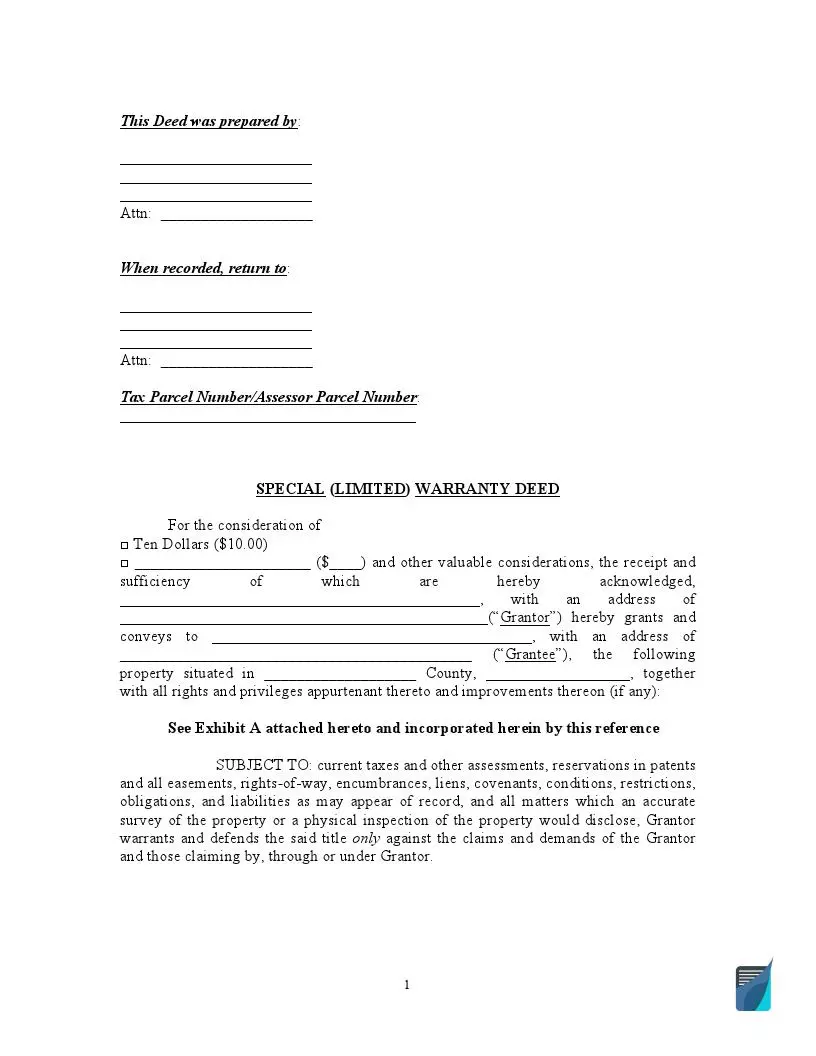Texas Special Warranty Deed Form
The Texas Special Warranty Deed is used to transfer property rights from one person to another. The seller guarantees the purity of the property title during the transfer, meaning that the title may have had some encumbrance in the past without the grantor’s knowledge.
Typically, these legalization terms are sufficient for the sale of real estate, so this form is commonly used with real estate transactions.

Build Your Document
Answer a few simple questions to make your document in minutes
Save and Print
Save progress and finish on any device, download and print anytime
Sign and Use
Your valid, lawyer-approved document is ready
Special Warranty Deed Laws and Requirements in Texas
The deed warrants that the current owner has not done anything leading to problems with the property title. Therefore, the property was not seized or put up as collateral during the last period of ownership. Thus, a free fillable special warranty deed form is applicable in the following cases:
- Transfer of ownership rights to organizations. In this case, the seller (grantor) transfers rights to an organization that the seller controls or manages and benefits from—for example, the seller’s own business or a trust.
- Sale of real estate. It is a prevalent type of transaction via the special warranty deed, as has been mentioned above. Here, operations are performed with commercial objects or multi-apartment real estate.
- The new owner is going to insure the property. If the buyer (grantee) purchases property insurance, the transfer does not depend on the object title’s purity. Thus, the nature of the title is irrelevant in this case.
- The current owner’s unwillingness to cope with title problems. The grantor refuses to be legally responsible for the title character, for example, dealing with the release of the object from the pledge.
Laws
The Special Warranty Deed operates under Texas Statutes , Property Code , Title 2 ( Conveyances ), Chapter 5 ( Conveyances ). The Chapter covers the legal relationship between the seller and the buyer and defines the rules for property rights transfer. Here you also find aspects of restrictions on the transfer of real estate, types of transfers, and so on.
Please note that you need to fill out the form following state law for the warranty to be valid in Texas. Read on to learn how to complete and submit the form correctly.
Signing Requirements
There are specific rules for signing a special warranty deed within the state of Texas. After the form is completed, signed, and notarized, it must be recorded at the Register of Deeds in the County Clerk’s Office. The seller and the buyer need to contact the clerk’s office in the county where the property is located.
Filing Requirements
The special warranty deed should be distinguished from the two other similar Texas deeds:
- The Texas Quitclaim Deed. This form is used to transfer property rights without verifying the title of the transferred object. As this issue is not relevant for quitclaim, the owner might sell the property in encumbrance. Therefore, this form is usually used between close relatives or when the parties trust each other fully.
- Texas Deed without Warranty. The paper also does not guarantee the seller’s responsibility for the purity of the title. Again, unlike these two forms, the Texas special warranty deed still gives the buyer confidence in the transferred title, but this guarantee is limited.
Format Requirements
The filler must follow the wording to state the provisions clearly. To correctly determine the nature of the transfer of rights in the act under consideration, you need to use the words “grant,” “sell,” and “convey” with “property.”
The deed must also include a written description of the object and comply with the formatting requirements (meaning the field’s size, font, and page numbering). Do not neglect these rules to avoid having to redo the paper again.
How to Fill Out and File a Special Warranty Deed in Texas
We encourage you to use our form-building tools to create and customize an up-to-date Warranty Deed template.
Following the instructions below, you can quickly and effortlessly fill out the form. Please focus on these few steps:
1. Fill in the Calendar Date
Here, you must enter the day, month, and year of the transfer.
2. Identify the Grantor
The grantor is the seller or current owner of the property. Insert their full legal name.
3. Identify the Grantee
The grantee is the buyer. Likewise, enter the full name and address of the property buyer.
4. Specify the Payment Amount
Enter the total amount the seller receives from the buyer in return for the premises.
5. Provide a Legal Description
The legal description involves specifying the dimensions, all possible measurements, and the boundaries of the property. You can use the data from an already existing deed or seek the surveyor’s service.
6. Sign the Form in Two Copies
Affix your signature, notarize the document and register it at the County Clerk’s Office. The seller and the buyer should keep a copy of the document.